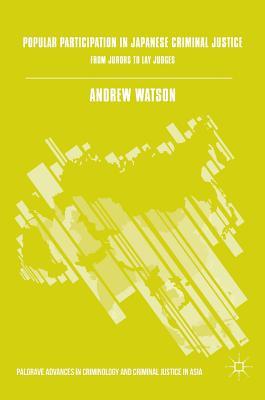Read Popular Participation in Japanese Criminal Justice: From Jurors to Lay Judges - Andrew Watson | PDF
Related searches:
2193 4023 338 51 3906 982 2092 2126 2077 4465 3117 2068 1231 195 2942 3142 2095 2283 3546
Popular participation in japanese criminal justice andrew watson from the meiji period (1868–1912) central government was the motor of economic transformation in japan.
Our findings are based on an 11-year prospective observational study using public ltci receipt data in japan.
The oligarchs of meiji, still active in the early twentieth century, viewed representative institutions and popular participation in politics with suspicious acceptance.
The dramatic growth of the japanese economy in the postwar period, and its meltdown in the 1990s, has attracted sustained interest in the power dynamics underlying the management of japan’s administrative state.
The japanese government implemented a public nursing care insurance law that includes an ltc prevention policy.
Public prosecutors also monopolized their power in criminal prosecution. One of the few exceptions to this principle of professionalism in japan was the jury trial.
Popular participation in the japanese legal process, edited by leon wolff, luke nottage, and kent anderson.
Popular participation in japanese criminal justice from jurors to lay judges by andrew watson and publisher palgrave macmillan. Save up to 80% by choosing the etextbook option for isbn: 9783319350776, 3319350773. The print version of this textbook is isbn: 9783319350769, 3319350765.
This article examines a case of participatory budgeting in japanese local government. The article politics, power, popular participation and pro-poor policy.
Popular participation in japanese criminal justice proceeds by explaining the process by which lay participation in criminal trials left the periphery to become an important national matter at the turn of the century.
Keywords: japan, aging, elderly, political participation, intergenerational justice.
Published by statista research department, mar 10, 2021 in 2020, the largest share of respondents, approximately 65 percent, stated that they had walked for physical exercise purposes.
The 1947 constitution establishes the principle of autonomy for local public entities.
Aug 5, 2020 people become more widely involved in the administration of justice together with legal professionals, the interface between the justice system.
Feb 3, 2020 previously, court cases had been exclusively decided by professionals such as judges.
Abstract: itai-itai disease was first noticed in the junzu river basin region in toyama prefec- ture in central japan around the 1930s.
Golf participation in japan — a measure of the number of people nationwide who play golf — has dropped by 40 percent since 1996, according to the tokyo shimbun newspaper.
The most powerful warlord, the shogun, ruled almost as a dictator.
Current roles for lay participation in japanese justice including the former jury system). Promotion of the public's understanding of the judicial system.
The expansion of online media as a public sphere for youth political participation created an ephemeral scholarly conversation.
Popular participation in japanese criminal justice proceeds by explaining the process by which lay participation in criminal trials left the periphery to become an important national matter at the turn of the century. It shows that rather than an anglo-american jury model, outline recommendations made by the japanese judicial reform council.
The book explores the extent to which the reforms transformed japan from an administrative state ruled by elites to a judicial state ruled by law with citizen participation in public life. Orthodox descriptions of japan’s governance structure focus on the firm control exercised by elite bureaucrats and the liberal democratic party.

Post Your Comments: